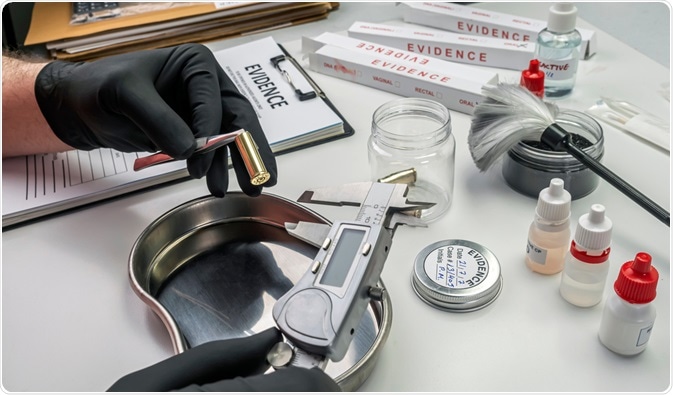Forensic ballistics refers to the science of firearms and projectiles in relation to the reconstruction of events leading to a gunshot injury. Aspects such as the geometry of a bullet tract and gunshot residue, or GSR, are commonly used in the essence of reconstructing events causing the gunshot injury on a biological target.

Forensic Ballistics. Image Credit: felipe caparros/Shutterstock.com
Furthermore, firearm examiners handle the task of linking bullets to the weapons utilized through microscopic analysis, and eventually the weapons to individuals firing those bullets. The latter link is done by examining obliterated serial numbers to determine the registered owner of that weapon.
Different types of existing ballistics
Four categories of ballistics include internal, transitional, external, and terminal ballistics. Internal ballistics depicts the event occurring from the time of the propellant's ignition until it reaches the end of the gun barrel. Transitional ballistics refers to the intermediate process between internal and external ballistics; when the projectile leaves the muzzle to when the equalization of the pressure behind the projectile is achieved.
External ballistics is the flight of the bullet after it leaves the barrel. While terminal ballistics refers to the particular behavior of the projectile when it meets its target.
Comparison microscope for the visual examination of bullets and cartridge cases
Every time that a bullet is fired, microscopic marks or commonly termed as 'ballistic fingerprints', are left on the bullet and cartridge case by the gun. When bullets are recovered from a crime scene, the marks deposited on the bullets from the crime scene can be compared to a bullet from the result of a test-fire with the suspect’s gun. This is done to indicate whether the bullets from both settings were fired from the same gun, with the same method of comparison also applying to cartridge cases.
Firearm examiners utilize a comparison microscope to compare two specimens side by side through two compound light microscopes, allowing the examiner to observe the two images in a single field of view from the center eyepiece. The specimen stages were connected by a system called the ‘optical bridge’ composing of prisms, mirrors, and lenses that allows the observation of both specimens simultaneously.
Class Characteristics vs. Individual Characteristics of Bullets
When a firearm examiner compares two bullets, they consider the two categories that the bullets can fall into class characteristics and individual characteristics. Class characteristics refer to the features that assign an object to a specific source of group, while individual characteristics are features of an object that with a high degree of certainty, can be assigned to a common source.
The class characteristics of bullets can be referred to as the caliber, direction of twist of the rifling, and the number of lands and grooves. These features are called class characteristics as multiple bullets can possess these characteristics that are not unique to an individual bullet. Whereas individual characteristics of a bullet come from the imperfections and marks as a result of corrosion, damage, or tools that produce the land and grooves of the bullet.
When an evidence bullet from a crime scene and the test bullets fired from a suspect firearm have common class characteristics as well as individual characteristics, the conclusion of the bullet being fired from the suspect’s firearm can be drawn.
GSR Analysis can determine if a firearm was used
Alongside the comparison analysis of bullets, gunshot residue can act as a tool to determine if a bullet had caused the defect on the target as well as the distance of the shooter to the target, also known as the ‘muzzle-to-target’ distance.
In addition, a gunshot residue test could indicate if a person had either fired a firearm or was in close proximity at the time the firearm was fired. The chemicals of the primer mixtures (lead, barium, antimony), metal, and unburnt gunpowder fused with heat settled onto nearby surfaces such as the human skin and clothing. The pattern as well as the pigmentation deposited on the surface indicates the proximity of the firearm to the surface.
Based on the observation of morphology and elemental analysis, the method of particle analysis can identify individual gunshot residue particles. Particle analysis can be done by scanning electron microscopy – energy dispersive x-ray spectrometry (SEM-EDS) for its measurement precision and non-destructiveness to preserve samples.
Nevertheless, some limitations could compromise the value of gunshot residue as evidence in the courtroom. One of the limitations being the proneness to remove GSR from a surface. Examiners have stated that gunshot residues are easily removed through the washing of hands or clothes, or by simply gentle rubbing of the skin in a pocket.
Another limitation is the lack of definitive proof to indicate which individual in close proximity to the weapon had actually fired it. Although this is typically seen as an advantage, the multiple numbers of suspects increase the turnaround time to eventually prosecute the offender from eliminating existing suspects.
References:
- Firearms n.d., NCDOJ, viewed 18 May 2021, <https://ncdoj.gov/crime-lab/firearms-and-tool-mark/#:~:text=Class%20characteristics%20are%20measurable%20features,which%20the%20bullet%20was%20fired.&text=Individual%20characteristics%20are%20marks%20unique%20to%20that%20particular%20firearm%20barrel>.
- Ballistics n.d., Human Slaughter Association, viewed 18 May 2921, <https://www.hsa.org.uk/ballistics/ballistics#:~:text=The%20science%20of%20projectiles%20and,%3A%20internal%2C%20external%20and%20terminal>.
- Ballistics n.d., NIST, viewed 18 May 2021, <https://www.nist.gov/ballistics>.
- Comparison microscopy n.d., Firearm Examiner Training, viewed 18 May 2021, <https://projects.nfstc.org/firearms/module07/fir_m07_t08_02.htm>.
- Gunshot residue collection n.d., Department of Public Safety Minnesota, viewed 18 May 2021, <https://dps.mn.gov/divisions/bca/bca-divisions/forensic-science/Pages/forensic-programs-crime-scene-gsr.aspx>.
- Examination of Gunshot Residue n.d., The Internet Pathology Laboratory for Medical Education n.d., viewed 17 May 2021, <https://webpath.med.utah.edu/TUTORIAL/GUNS/GUNGSR.html>.
Further Reading
Last Updated: Jul 28, 2021